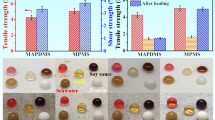Abstract
Progresses in the development of self-healing materials have resulted in transition from repairing damaged materials via external interference to autonomous internal healing process. This paper explores reaction between acrylated expoxidized soybean oil (AESO) with pentaerythritol tetrakis(3-mercaptopropionate) (PETMP) hardener, followed by microencapsulation of AESO for its potential use in a novel self-healing system. Self-healing reaction involving AESO and PETMP is considered more environmentally friendly than most of the reported self-healing reactions not only because AESO is derived from renewable resources, but also due to the fact that the reaction does not rely on any heavy metal catalyst. Such catalysts are usually introduced in a self-healing system to speed up the intended healing process and it could be very harmful to the environment and also to the end users. It was found that AESO and PETMP are able to crosslink with each other and solidify at room temperature within 15 min of mixing. The reaction occurs readily at room temperature without any external interference, suggesting the viability of the reaction to be utilized in an autonomous self-healing system. This paper follows through with microencapsulation of AESO in melamine-urea-formaldehyde, and result of the characterizations reveal that the microcapsules obtained are spherical with average diameter of around 150 µm, free-flowing, thermally stable at temperature up to 200 °C, and the calculated % of microencapsulation reached as high as 86.4%.












Similar content being viewed by others
References
Pang JWC, Bond IP (2005) Compos Sci Technol 65:1791–1799
Lee MW, An S, Yoon SS, Yarin AL (2018) Adv Colloid Interface Sci 252:21–37
Ahangaran F, Hayaty M, Navarchian AH (2017) Appl Surf Sci 399:721–731
Kongparakul S, Kornprasert S, Suriya P, Le D, Samart C, Chantarasiri N, Prasassarakich P, Guan G (2017) Prog Org Coat 104:173–179
Kim JR, Netravali AN (2017) J Mater Sci 52:3028–3047
Lang S, Zhou Q (2017) Prog Org Coat 105:99–110
Chung US, Min JH, Lee PC, Koh WG (2017) Colloids Surf A 518:173–180
White SR, Sottos NR, Guebelle PH, Moore JS, Kessler MR, Sriram SR, Brown EN, Viswanathan S (2001) Nature 409:794–797
Cho BSH, Anderson HM, White SR, Sottos NR, Braun PV (2006) Adv Mater 18:997–1000
Kessler MR, White SR (2001) Compos A 32:683–699
Kessler MR, Sottos NR, White SR (2003) Compos A 34:743–753
Brown EN, White SR, Sottos NR (2004) J Mater Sci 39:1703–1710
Brown EN, White SR, Sottos NR (2005) Compos Sci Technol 65:2466–2480
Suryanarayana C, Chowdoji RK, Dhirendra K (2008) Prog Org Coat 63:72–78
Yuan YC, Rong MZ, Zhang MQ, Chen J, Yang GC, Li XM (2008) Macromolecules 41:5197–5202
Saman N, Ang DTC, Shahabudin N, Gan SN, Basirun WJ (2018) J Coat Technol Res. https://doi.org/10.1007/s11998-018-0124-x
Guzmán D, Mateu B, Fernández-Francos X, Ramis X, Serra A (2017) Polym Int 66:1697–1707
Konuray AO, Fernández-Francos X, Ramis X (2017) Polym Chem 8:5934–5947
Shahabudin N, Yahya R, Gan SN (2015) Macromol Symp 354:305–313
Tong XM, Zhang T, Yang MZ, Zhang Q (2010) Colloids Surf A 371:91–97
Rule JD, Sottos NR, White SR (2007) Polymer 48:3520–3529
Koh E, Kim NK, Shin J, Kim YW (2014) RSC Adv 4:16214–16223
Kim DM, Cho YJ, Choi JY, Kim BJ, Jin SW, Chung CM (2017) Materials 10:1079. https://doi.org/10.3390/ma10091079
Giannaros P, Kanellopoulos A, Al-Tabbaa A (2016) Smart Mater Struct. https://doi.org/10.1088/0964-1726/25/8/084005
Acknowledgements
The author would like to thank Ministry of Science and Technology Malaysia (MOSTI) for its financial support through e-sciencefund research Grant (SF006-2015).
Author information
Authors and Affiliations
Corresponding author
Rights and permissions
About this article
Cite this article
Saman, N.M., Ang, D.T.C. & Gan, S.N. Acrylated Epoxidized Soybean Oil as a Green Alternative Healant in Development of Autonomous Self-Healing Materials. J Polym Environ 27, 118–126 (2019). https://doi.org/10.1007/s10924-018-1328-y
Published:
Issue Date:
DOI: https://doi.org/10.1007/s10924-018-1328-y




